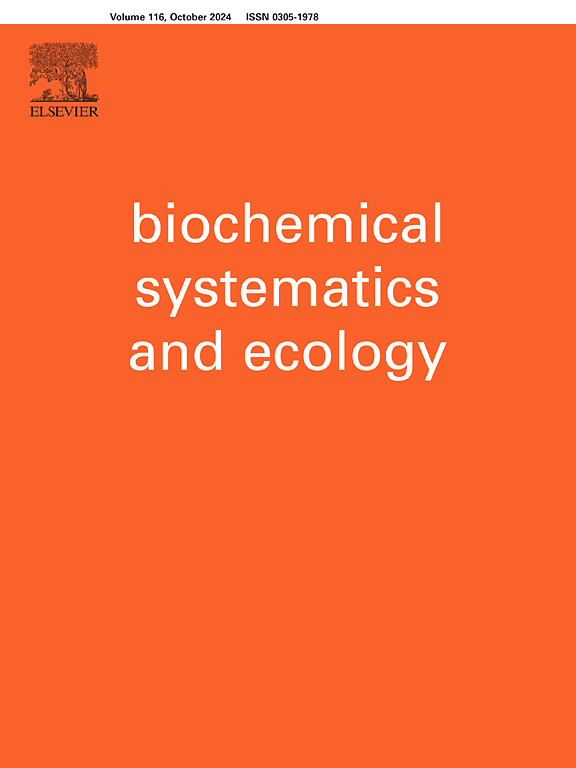Cytotoxic stilbenoid from the leaves and stems of Cassia nodosa
IF 2
4区 生物学
Q4 BIOCHEMISTRY & MOLECULAR BIOLOGY
引用次数: 0
Abstract
One new stilbene, trans-3,2′-dihydroxy-3′,4′,5-trimethoxy stilbene (1), together with seven known ones (2–8) were isolated from the leaves and stems of Cassia nodosa Buch.-Ham. ex Roxb (Fabaceae). The structure of the new compound was elucidated via analyses of NMR (1 D and 2 D) and HRESIMS data. To the best of our knowledge, all the known compounds were isolated from the genus Cassia for the first time. Cytotoxicity and anti-neuroinflammatory activities assay of the isolated compounds revealed that 1 exhibited significant cytotoxicity superior to the positive control cisplatin against MDA-MB-231 and MCF-7 cell lines. Furthermore, the chemotaxonomic significance of the isolates was also discussed, building upon our previous studies on flavonoids, anthraquinones, terpenoids, and flavan derivatives from C. nodosa, which collectively enrich the phytochemical profile of this species and support its classification within the genus Cassia.
决明子叶和茎的细胞毒性二苯乙烯类化合物
从决明子(Cassia nodosa buchh .- ham)的叶和茎中分离到1个新的二苯乙烯(trans-3,2 ' -二羟基-3 ',4 ',5-三甲氧基二苯乙烯(1)和7个已知的二苯乙烯(2 - 8)。原豆科植物。新化合物的结构通过NMR (1d和2d)和HRESIMS数据进行了分析。据我们所知,所有已知化合物均为首次从决明子属中分离得到。细胞毒性和抗神经炎活性分析表明,1对MDA-MB-231和MCF-7细胞系的细胞毒性明显优于阳性对照顺铂。此外,我们还讨论了分离物的化学分类意义,基于我们之前对C. nodosa的黄酮类、蒽醌类、萜类和黄酮类衍生物的研究,这些分离物共同丰富了该物种的植物化学特征,并支持其在决明子属中的分类。
本文章由计算机程序翻译,如有差异,请以英文原文为准。
求助全文
约1分钟内获得全文
求助全文
来源期刊

Biochemical Systematics and Ecology
生物-进化生物学
CiteScore
3.00
自引率
12.50%
发文量
147
审稿时长
43 days
期刊介绍:
Biochemical Systematics and Ecology is devoted to the publication of original papers and reviews, both submitted and invited, in two subject areas: I) the application of biochemistry to problems relating to systematic biology of organisms (biochemical systematics); II) the role of biochemistry in interactions between organisms or between an organism and its environment (biochemical ecology).
In the Biochemical Systematics subject area, comparative studies of the distribution of (secondary) metabolites within a wider taxon (e.g. genus or family) are welcome. Comparative studies, encompassing multiple accessions of each of the taxa within their distribution are particularly encouraged. Welcome are also studies combining classical chemosystematic studies (such as comparative HPLC-MS or GC-MS investigations) with (macro-) molecular phylogenetic studies. Studies that involve the comparative use of compounds to help differentiate among species such as adulterants or substitutes that illustrate the applied use of chemosystematics are welcome. In contrast, studies solely employing macromolecular phylogenetic techniques (gene sequences, RAPD studies etc.) will be considered out of scope. Discouraged are manuscripts that report known or new compounds from a single source taxon without addressing a systematic hypothesis. Also considered out of scope are studies using outdated and hard to reproduce macromolecular techniques such as RAPDs in combination with standard chemosystematic techniques such as GC-FID and GC-MS.
 求助内容:
求助内容: 应助结果提醒方式:
应助结果提醒方式:


